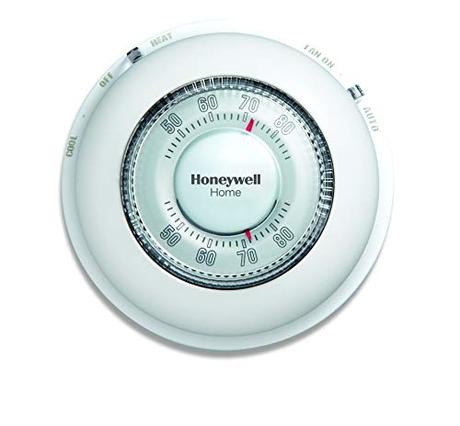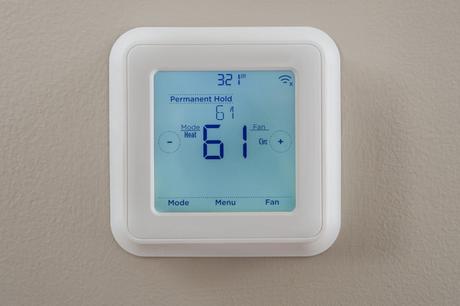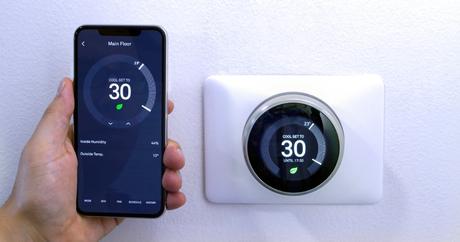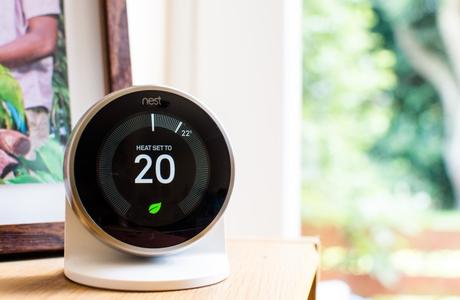Most homes have thermostats. But the majority of homeowners don't know they have other options to control the heating and cooling of their home. As long as the thermostat turns your heating and air conditioning on, you likely won't be looking for a new one.
However, since your thermostat is the "brain" of your HVAC system, a good one can provide you with efficient control. This means replacing your old thermostat can drastically lower your monthly energy bills.
This guide covers how thermostats work and the most common types, continue reading to learn more.

How Thermostats Work
The basics of how thermostats work are relatively simple. All thermostats have a temperature setpoint that the homeowner can adjust, along with a switch for heating and cooling mode.
When the thermostat is set to heating mode, the thermostat turns the HVAC on to heat. This means as the temperature in your home decreases, the thermostat will call on your heat pump or furnace to provide more heat until the temperature reaches the set point.
On the flip side, a thermostat set to cooling mode lowers your home's temperature. As the temperature increases in your home, the thermostat will tell your heat pump or air conditioner to pump more cool air into your home and stop once the temperature decreases to your setpoint.
Thermostats can be low voltage or line voltage, but they work the same fundamental way regardless of their power input.
Line Voltage vs. Low Voltage

Single heating systems, like baseboard heaters and radiators, commonly use line-voltage thermostats. Line voltage units use the same voltage, usually 240V, as your heating system and directly control the power to your heater.
On the other hand, low voltage thermostats run on 24V to 50V input and control most types of HVAC systems, such as:
- Central air conditioners
- Air-source heat pumps
- Gas and electric furnaces
- Gas and electric boilers
Low-voltage thermostats usually are more accurate and more efficient than their line-voltage counterparts.
How Thermostats Connect to Your HVAC System

All thermostats have a sensor that measures temperature along with a set point adjustment, which the homeowner sets, and a switch to toggle between heating and cooling modes.
Your thermostat compares the setpoint temperature to the temperature it measures and uses that to tell your HVAC system when to run.
The thermostat tells the HVAC system to add cooling if the temperature is above the setpoint in cooling mode.
In heating mode, if the temperature it measures is lower than the setpoint, it tells the HVAC system to heat your home.
The specific way thermostats measure temperature and control your heating and cooling differ depending on whether you have a digital or mechanical thermostat.
Digital vs. Mechanical Thermostats
Old thermostats were mechanical in operation. They contain a coiled bimetal strip that expands and contracts as the temperature changes.
A bimetal strip is literally two strips of metal that are fused together side-by-side. Each metal has different properties, including how they expand and contract with temperature changes.
One metal expands and contracts more than the other metal, causing the coiled strip to bend or straighten. The end of the bimetal strip hits a physical switch within your thermostat to control your HVAC system.
A common switch design paired with bimetal strips was a glass bulb filled with mercury with two wires connected on both sides. Mercury conducts electricity very well, and the bimetal strip would tilt the bulb so that the liquid mercury touches both wires within the bulb to complete the circuit and provide electricity to an air conditioner or furnace.
Liquid mercury bulbs were phased out of production and replaced with physical snap switches due to mercury's harmful impact on the environment and people.
Based on testing, the reaction of the bimetallic strips to temperature changes is predictable and mechanical thermostats use them to measure temperature accurately.
On the other hand, digital thermostats use a digital (non-mechanical) temperature sensor to monitor the temperature change in your home.
There are no moving parts, and instead, it uses a thermistor combined with a circuit board to control your heating and cooling. Compared to mechanical thermostats, digital units have a faster response time.
Mechanical thermostats usually have a mechanical dial or sliding switch for the setpoint adjustment, while electronic thermostats have either buttons or a touchscreen.
Which are More Common?
Digital thermostats are the most common today for the following reasons:
- They're less expensive to make
- Have more reliability
- Measure temperature more accurately
- Respond to changing temperature faster
- Last longer
Many new "mechanical-looking" dial-type thermostats are actually digital thermostats. The only thing mechanical about them is the movable dial for adjusting the set point. They no longer use bimetallic strips. Instead, they use a thermistor since it's easier and cheaper to manufacture.
Many older homes still have old mechanical thermostats. However, any new thermostat you buy will be digital unless you're a time traveler (in that case, we recommend you purchase lottery tickets, not thermostats).
Types of Thermostats
Besides the differences between mechanical and digital, there are different types of control and sophistication of thermostats.
As with most types of technology, thermostats have made advancements over the years, from non-programmable units to full-on smart thermostats you can control with your smartphone.
Here is how they compare.
Non-Programmable Thermostats

Non-programmable thermostats are the most basic and lowest cost thermostats available. These thermostats only have manual control, which means you'll have to get up and walk to the thermostat any time you want to change the temperature.
Non-programmable units are available in push button styles like this Honeywell non-programmable thermostat or a dial-type setpoint adjustment like the Honeywell Home CT87N1001 Round Non-Programmable Manual Thermostat.
Programmable Thermostat

Programmable thermostats are one step above their non-programmable counterparts, with a slight increase in cost. You can program them to change temperature based on the day of the week and time of day.
They usually have a grayscale touchscreen, like this Honeywell Home RTH7600D 7-Day Programmable Touchscreen Thermostat, to make setting the schedule simple.
The advantage of a programmable thermostat is simple: it increases your HVAC system's energy efficiency by automatically changing the temperature when you're sleeping or at work.
However, sometimes programming a thermostat can be tricky, especially if you decide to change it months later and have forgotten how to change things.
Wi-Fi Thermostat

Wi-Fi thermostats are essentially programmable thermostats that connect to (you guessed it) Wi-Fi! Connecting to Wi-Fi means you can set up the programming and scheduling on the thermostat itself or make changes wirelessly.
This means if you have a Wi-Fi unit like the Emerson Sensi Wi-Fi Smart Thermostat, you can change the temperature settings and schedule from the convenience of your smartphone or your computer.
So, if you're feeling chilly while you're binging movies on your day off, you don't have to get up off the couch to adjust the thermostat (assuming you have your smartphone next to you).
Wi-Fi thermostats cost on average 30% to 50% more than simple programmable thermostats but offer a more convenient and easier way to set up and change programming.
Smart Thermostat

Smart thermostats are the most technologically advanced thermostats on the market. They provide the most efficient control of your HVAC system, the best home comfort, and the most convenience in the climate control of your home.
Plus, they learn patterns, like when you leave for work or come home, and seamlessly integrate with other smart home devices like Amazon Alexa, Google Assistant, or Apple HomePod.
This means tech-savvy homeowners can control their HVAC through voice commands, mobile apps, or with the thermostat itself.
Popular models include the Google Nest thermostat and the ecobee SmartThermostat. Most smart thermostats provide advanced features like zone control, pairing with additional temperature sensors, humidity control, maintenance reminders, and error/failure reporting.
Smart thermostats "learn" how your HVAC system responds and optimizes its run time to use the least amount of energy while keeping your home comfortable.
As such, they save homeowners money on their heating and cooling bills. However, they have the highest upfront cost of all thermostat types.
Your thermostat controls the HVAC system in your home and is responsible for measuring and maintaining its indoor temperature. Many types of thermostats are available to homeowners, including non-programmable, programmable, Wi-Fi, and smart thermostats.
Non-programmable thermostats are the cheapest but will lead to larger energy costs. Smart thermostats, like the Google Nest thermostat, are the most expensive but provide the highest efficiency and lowest energy costs.
All homes with an HVAC system need a thermostat, so choose one that has the best features for you!
Comment what type of thermostat you use- and feel free to drop in any questions too!
